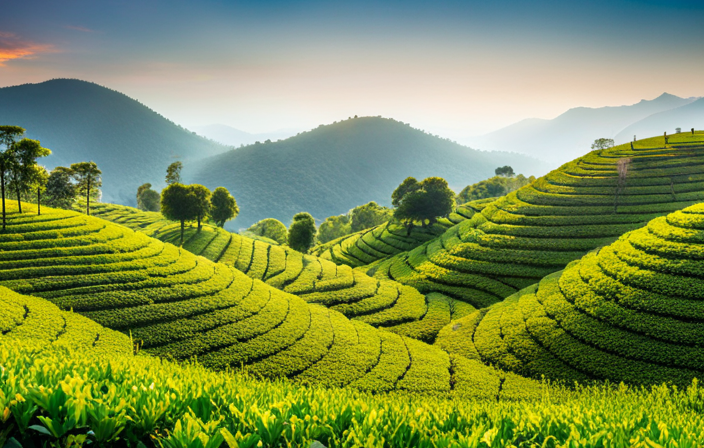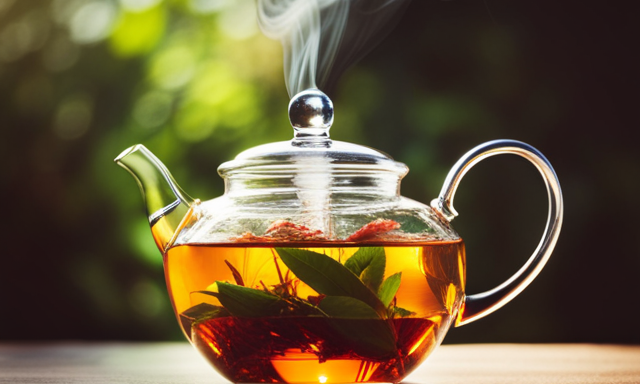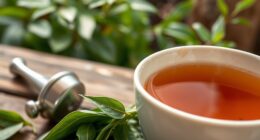As a passionate tea enthusiast, I am fascinated by the rich history and cultural significance of this beloved beverage.
From its humble beginnings in ancient China to its global spread and influence, tea has shaped modern tea culture in ways that are both profound and intriguing.
By exploring the journey of tea, we can delve into the intricate connections between different cultures, the impact of colonialism, and the evolution of tea ceremonies and rituals.
Join me on this captivating journey as we uncover the fascinating story of tea.
Key Takeaways
- Tea originated in ancient China and has medicinal properties.
- The spread of tea from China to Japan influenced tea culture in Japan and transformed the tea experience.
- The introduction of tea to Europe led to its embrace by the European nobility, the rise of royal tea parties, and rampant tea smuggling.
- The tea trade during the era of colonialism gave European powers significant advantages in global politics and the British Empire became heavily reliant on tea as a source of revenue.
Tea’s Origin in China: The Birth of a Global Beverage
I can’t believe that tea, a beverage that originated in China, has become such a global phenomenon. It’s fascinating to think about how this humble drink has transcended borders and cultural boundaries to become a staple in many people’s lives.
One of the reasons for tea’s widespread popularity lies in its medicinal properties. From boosting immunity to aiding digestion, tea has been used for centuries as a natural remedy for various ailments.
Moreover, tea has played a significant role in shaping social interactions. Whether it’s a casual chat over a cup of tea or a formal tea ceremony, this beverage brings people together, fostering connections and creating a sense of community. It’s incredible to witness how tea hasn’t only nourished our bodies but also enriched our social lives.
The Spread of Tea in Asia: From China to Japan and Beyond
Tea hasn’t only become a popular beverage in China, but it has also spread to Japan and other Asian countries, enchanting millions of tea lovers in the region.
The journey of tea from China to Japan has shaped modern tea culture in numerous ways. In Japan, tea isn’t just a drink, but a reflection of their rich cultural heritage. One notable influence is the Chinese tea ceremony, which was introduced to Japan during the Tang Dynasty. This ceremony emphasizes the art of tea preparation, the appreciation of tea, and the connection between the participants.
Today, tea houses in Japan are a common sight, offering a serene and tranquil environment for tea enthusiasts to enjoy their favorite brews. These tea houses often follow traditional Japanese aesthetics, providing a space for relaxation and contemplation.
The spread of tea from China to Japan has truly transformed the way we appreciate and experience this beloved beverage.
Tea’s Introduction to Europe: A Beverage Fit for Royalty
The European nobility embraced tea as a luxurious beverage, elevating its status to that of a regal delight. Royal tea parties became a symbol of wealth, refinement, and social status. These extravagant gatherings were meticulously planned, with sumptuous spreads of delicacies and the finest tea served in exquisite china.
However, the path to tea’s popularity in Europe wasn’t without its challenges. Tea smuggling became rampant due to high taxes imposed on this prized commodity. The allure of tea was so strong that people went to great lengths to obtain it, evading authorities and risking punishment. This underground trade only fueled the demand for tea, making it even more coveted.
The rise of tea in Europe set the stage for colonization and the tea trade, which would go on to shape global empires.
Colonization and the Tea Trade: How Tea Shaped Global Empires
Growing up in a world shaped by colonization and the tea trade, it’s fascinating to see how tea has influenced the rise and fall of global empires.
The history of tea is deeply intertwined with the era of colonialism, as European powers sought to establish control over tea-producing regions in Asia. This economic impact was immense, as the demand for tea led to the expansion of empires and the establishment of trade routes.
The British Empire, for example, became heavily reliant on tea as a source of revenue, leading them to establish plantations in India and control the tea trade through their East India Company. This control over the tea trade gave them a significant advantage in global politics and allowed them to exert their influence over other nations.
As the discussion shifts to modern tea culture, it’s important to understand the historical context in which tea gained its significance and how it continues to shape our traditions and rituals today.
Modern Tea Culture: From Cultural Significance to Ceremonies and Rituals
As I delve into the topic of modern tea culture, I can’t help but be intrigued by the cultural significance and the intricate ceremonies and rituals associated with it. Tea ceremonies and rituals have been an integral part of various cultures for centuries, symbolizing hospitality, respect, and harmony. These traditions not only bring people together but also provide a sense of tranquility and mindfulness in our fast-paced world.
To further understand the depth of tea culture, let’s take a closer look at some of the most well-known tea ceremonies and rituals from around the world:
| Tea Ceremony/Ritual | Origin | Key Features |
|---|---|---|
| Chinese Tea Ceremony | China | Gongfu brewing, strict etiquette, emphasis on aroma and taste |
| Japanese Tea Ceremony | Japan | Matcha preparation, tranquil environment, focus on Zen principles |
| Moroccan Tea Ritual | Morocco | Mint tea preparation, pouring technique, symbol of hospitality |
| British Afternoon Tea | Britain | Elegant tea service, tiered trays of sandwiches and pastries, social gathering |
These ceremonies and rituals not only showcase the beauty and diversity of tea culture but also provide a unique opportunity for individuals to connect with themselves, others, and the rich history of tea. Whether it’s a formal ceremony or a casual gathering, tea rituals serve as a reminder to slow down, appreciate the present moment, and savor the simple pleasures in life.
Frequently Asked Questions
What Are the Health Benefits of Tea?
Tea has numerous health benefits that make it a popular beverage choice.
One of the key benefits of tea is its high content of antioxidants. These antioxidants help to protect our cells from damage, which can reduce the risk of chronic diseases such as heart disease and certain types of cancer.
Additionally, tea has been shown to improve brain function, promote weight loss, and boost the immune system.
Overall, incorporating tea into your daily routine can have a positive impact on your health.
How Is Tea Produced and Processed?
Tea cultivation involves carefully tending to the tea plants, nurturing them like delicate flowers in a garden. The leaves are hand-picked by skilled farmers, ensuring only the finest quality.
After harvesting, the leaves undergo a process called fermentation, where they’re carefully oxidized to bring out their unique flavors. This process is crucial in shaping the taste and aroma of the final tea product.
The journey of tea production is a meticulous and artful craft, resulting in the exquisite teas that we enjoy today.
What Are the Different Types of Tea and How Do They Differ From Each Other?
When it comes to tea, there are various types that differ based on the grading systems and regional variations in production. Each type has its own unique characteristics and flavors.
Understanding the differences between them can help in choosing the right tea for different occasions or preferences.
Exploring the world of tea and its diverse offerings is a fascinating journey that allows us to appreciate the rich history and cultural significance behind this beloved beverage.
What Is the Role of Tea in Different Cultures and Societies Today?
Tea plays a significant role in different cultures and societies today. Its cultural significance goes beyond being just a beverage. It’s often associated with social rituals and gatherings, symbolizing hospitality and warmth.
In many countries, such as China, Japan, India, and Britain, tea ceremonies and traditions have been passed down through generations. These rituals not only showcase the appreciation for tea but also serve as a way to connect and bond with others.
How Has the Tea Industry Evolved Over Time and What Are the Current Trends in Tea Consumption?
Tea trends and the growth of the tea market have seen significant evolution over time.
As an avid tea enthusiast, I’ve witnessed the rise of specialty teas, such as matcha and herbal infusions, which have become increasingly popular.
Moreover, there’s been a shift towards more sustainable and ethical tea production, with consumers demanding transparency and fair trade practices.
The current tea consumption trends reflect a desire for unique flavors, health benefits, and a deeper connection to the origins of the tea we enjoy.
Conclusion
In conclusion, the journey of tea has been a fascinating one, shaping modern tea culture as we know it today. From its origins in China to its spread throughout Asia and introduction to Europe, tea has transcended borders and become a global beverage.
Its influence on colonization and global trade can’t be underestimated. Moreover, the cultural significance of tea and the ceremonies and rituals associated with it have added a touch of elegance and tradition to our daily lives. One example that highlights this is the Japanese tea ceremony, which embodies harmony, respect, and tranquility.










